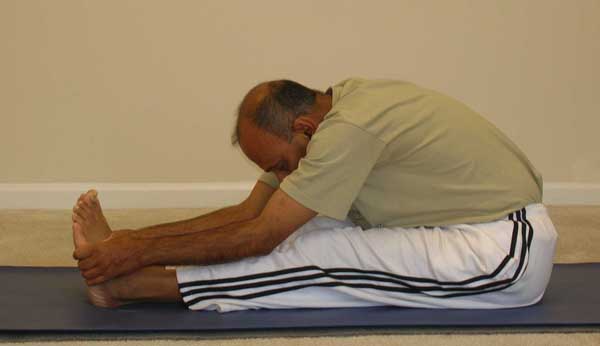(Guest post by Madhusoodanan Sunderesan)

Pashchimottanasana (Forward Bend)
After a late night party, or a sumptuous dinner with family and friends with your favorite sweets, have you felt terribly thirsty, drinking lots of w ater and going to the bathroom frequently? Perhaps you have felt tired out, dizzy and hungry after a long walk or work out in the gym. These are not uncommon. These are, however, more pronounced if you are a diabetic-when the sugar level in your blood fluctuates from a very high in the first instance to low/very low in the second instance.
More and more people around the world are being diagnosed with diabetes every day. By 2030, 87 million Indians will have diabetes.
Diabetes is no longer a rich man’s disease or a life-style disease. About 80% of all the diabetics now live in low and middle income countries of the world.
People with diabetes are prone to a number of complications involving kidneys, heart, brain, nerves, feet and mouth infections.
Simple yoga postures that can be practiced in about 30 minutes a day can help to control your sugar levels along with your medications and a well planned diet.
It is important that you start the practice of these asanas after consultations with your physician under the guidance of an expert teacher. Women who develop diabetes during pregnancy (gestational diabetes) must avoid postures involving stretching and abdominal twists that affect the uterus. They must check with their doctors regarding the practice of these specific asanas.
Prediabetes is a condition where sugar levels are higher than in healthy people, but not high enough to be termed as diabetic.
Those suffering from gestational diabetes or prediabetes have a high tendency of turning into Type 2 diabetics. They stand to benefit from yoga practice, a change in lifestyle and a good diet plan.
The asanas described here would benefit everyone with problems of digestion. Other benefits for each of these asanas are described on the website.
The yoga sequence recommended is:
Suryanamaskar 1-2 rounds, vakrasana, mandukasana, yoga mudrasana, pashchimottanasana, (3-5 rounds each) and kapalabhati.
Subhash’s blog and website deal with most of these asanas.
Surya namaskar means Sun salutation. It is a combination of twelve postures. The practice is best done after becoming familiar with the postures individually. The postures are
- Pranamasana—Prayer pose
- Hasta Uttanasana —-Raised arms pose
- Padahastanasana—Hand to foot pose
- Ashwasanchalasana –The equestrian pose
- Parvatasana—Mountain pose
- Ashtanga namskara—Salutation with eight limbs
- Bhujangasana—Serpent pose
- Parvatasana—Mountain pose
- Ashwasanchalasana—The equestrian pose
- Padahastanasana—Hand to foot pose
- Hasta Uttanasana —-Raised arms pose
- Pranamasana—Prayer pose
Once you are comfortable with the sequence, synchronization with the breath can be done.
For instructions and details please visit the blog here.
Paschimottanasan—Seated-forward-bend
This asana helps the hamstring muscles, and hip joints . It also massages the pelvic and abdominal areas; pancreas, spleen, liver and kidneys. Visit the blog for instructions and details.

Yoga Mudra (Yoga Seal)
Yoga Mudra—–Yoga seal
This asana helps massage the liver, pancreas, intestines and is useful for easing ailments like constipation and diabetes. Visit the blog for instructions and details.
Kapalabhati pranayama—Frontal brain cleansing breath.
Kapalabhati pranayama has tremendous beneficial effects to be termed as- “ a cure for virtually all ailments”. Be careful about the contraindications given.
This pranayama has benefits that are being discovered anew after so many centuries.
Practice this for some diabetic complications discussed later in this blog.
Visit the blog for instructions and details.
Vakrarsana (twisted pose) and Mandukasana (frog pose) can be practiced with the instructions given below.
A.Vvakrasana,
- Fold the right leg vertically to keep your right foot next to left knee. The sole should be flat on the ground.
- Keep your right hand at the back and place it in line with the spinal cord
- Bring your left hand over the stomach and place it near the right toes. Turn the neck to the right twisting the spinal cord
- Left foot, right hand and waist should remain straight as you look straight ahead.
Hold the position for 30 seconds to 1 minute
Repeat the posture on the other side.
Once you are comfortable with vakrasana, you may attempt slightly more challenging posture of ardhamatsyendrasana. Visit the blog for details.
B. Mandukasana,
- Sit in vajrasna with the spine straight
- Close the fists of both hands with the thumb inside the fingers. A variation is to keep your left palm on the navel and the right palm on top of the left palm. Palms may be reversed also.
- Press either side of the navel with the fists or on the navel when the palms are placed on it.
- Exhale and bend forward looking straight ahead with chests pressing against the folded legs.
- Hold for 30 seconds to 1 minute and return to the starting posture inhaling.
If sitting in vajrasana is not comfortable, you may cross legged (sukhasana) or you may sit on a chair with a straight back with feet resting on the floor.
Do not worry about getting it “perfect” when you are begin the practice of these asanas. You will get there in course of time.
Yoga is very useful in preventing diabetic complications.
The trick is to perform kapalabhati on an empty stomach first to learn the technique.
It is certain that yoga has an important role to play in tackling diabetes when undertaken along with medications and a controlled diet. One can “enjoy” the normal sugar levels and avoid the complications that arise out of uncontrolled diabetes.
Recent Comments